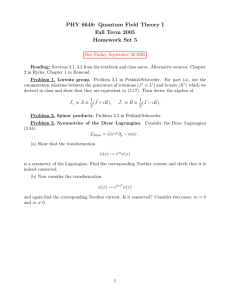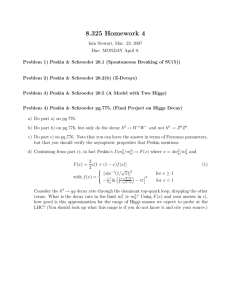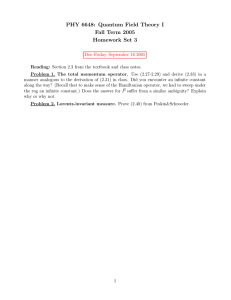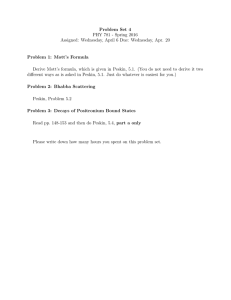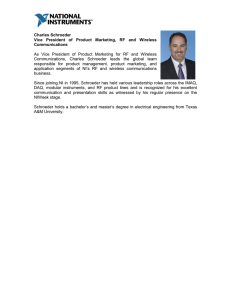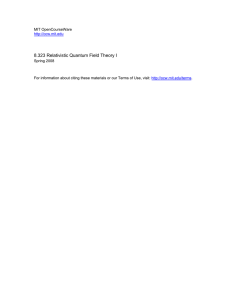Document 13470496
advertisement
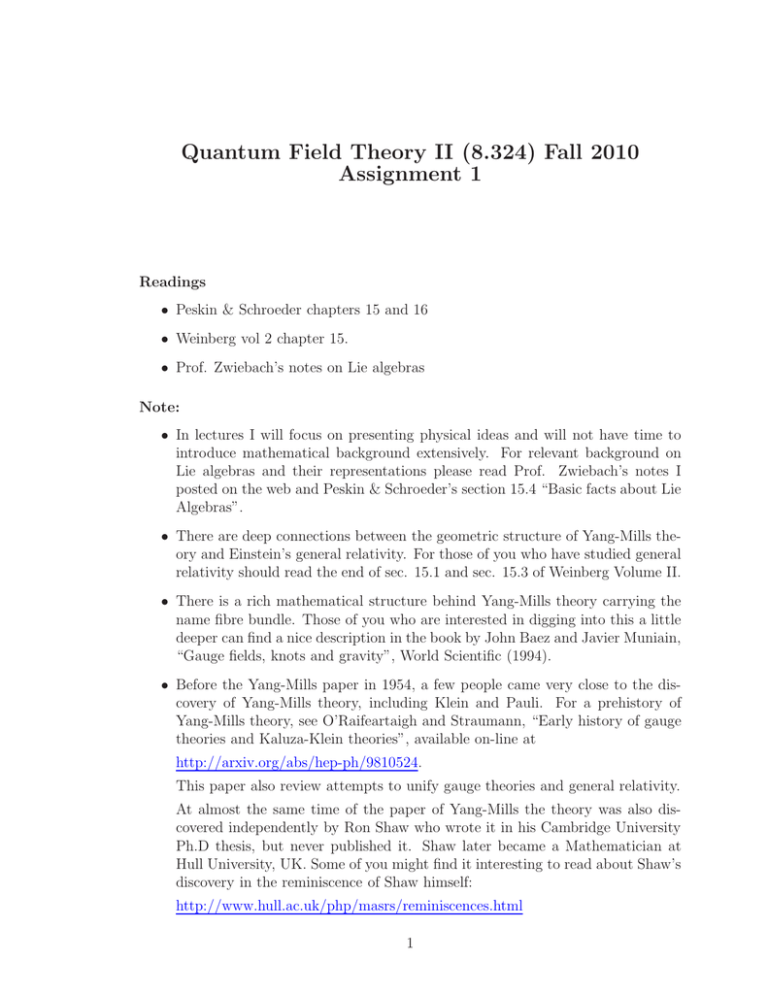
Quantum Field Theory II (8.324) Fall 2010 Assignment 1 Readings • Peskin & Schroeder chapters 15 and 16 • Weinberg vol 2 chapter 15. • Prof. Zwiebach’s notes on Lie algebras Note: • In lectures I will focus on presenting physical ideas and will not have time to introduce mathematical background extensively. For relevant background on Lie algebras and their representations please read Prof. Zwiebach’s notes I posted on the web and Peskin & Schroeder’s section 15.4 “Basic facts about Lie Algebras”. • There are deep connections between the geometric structure of Yang-Mills the­ ory and Einstein’s general relativity. For those of you who have studied general relativity should read the end of sec. 15.1 and sec. 15.3 of Weinberg Volume II. • There is a rich mathematical structure behind Yang-Mills theory carrying the name fibre bundle. Those of you who are interested in digging into this a little deeper can find a nice description in the book by John Baez and Javier Muniain, “Gauge fields, knots and gravity”, World Scientific (1994). • Before the Yang-Mills paper in 1954, a few people came very close to the dis­ covery of Yang-Mills theory, including Klein and Pauli. For a prehistory of Yang-Mills theory, see O’Raifeartaigh and Straumann, “Early history of gauge theories and Kaluza-Klein theories”, available on-line at http://arxiv.org/abs/hep-ph/9810524. This paper also review attempts to unify gauge theories and general relativity. At almost the same time of the paper of Yang-Mills the theory was also dis­ covered independently by Ron Shaw who wrote it in his Cambridge University Ph.D thesis, but never published it. Shaw later became a Mathematician at Hull University, UK. Some of you might find it interesting to read about Shaw’s discovery in the reminiscence of Shaw himself: http://www.hull.ac.uk/php/masrs/reminiscences.html 1 Problem Set 1 1. Non-Abelian global symmetries and the associated charges (30 points) Consider the following Lagrangian ¯ µ ∂µ − m)Ψ L = −iΨ(γ where � � ψ1 Ψ= , ψ2 (1) � � ¯ = ψ¯1 , ψ¯2 Ψ (2) ψ1,2 are Dirac spinor fields. We will suppress spinor indices throughout. (a) Show that (1) is invariant under infinitesimal transformations δΨ = iǫa Ta Ψ, Ta = σa , 2 a = 1, 2, 3 (3) where σa are Pauli matrices. (b) Find the conserved currents Jaµ corresponding to the symmetric transfor­ mations (3). (c) Write down the corresponding conserved charges Qa , a = 1, 2, 3. Show that δΨ = i[ǫa Qa , Ψ] (4) (d) Find the commutation relations between Qa ’s (using the canonical com­ mutators). (e) Let Û = exp (iΛa Qa ) , U = exp (iΛa Ta ) (5) for some constants Λa . Note that Û is a quantum operator, while U is a 2 × 2 unitary matrix. Show that Û Ψ Û † = UΨ . (6) 2. Parallel transport around a small loop (20 points) Consider a small closed loop C which we take to be a parallelogram with one corner at xµ and two sides aµ and bµ . Denote the transport around the loop to be UC (x, x). Show that UC (x, x) can be expressed in terms of the field strength in both U(1) and general non-Abelian case. You should write down the explicit expressions of UC (x, x) in terms of the field strength. State how this result can be generalized to an arbitrary small closed loop. 2 3. Bianchi identity (15 points) Check the Bianchi identity Dµ Fνλ + Dλ Fµν + Dν Fλµ = 0 (7) Dµ Fνλ ≡ ∂µ Fνλ − ig[Aµ , Fνλ ] (8) where 4. Scalar propagator in a gauge theory (35 points) (a) Peskin & Schroeder prob. 15.4 part (a) (b) Peskin & Schroeder prob. 15.4 part (b) (c) Consider n complex scalar fields of mass m arranged in a vector φ1 .. Φ= . (9) φn Write down a U(n) gauge invariant Lagrangian for Φ. You can assume that Φ has no self-interactions. (d) Peskin & Schroeder prob. 15.4 (c) (using the Lagrangian you obtained in part (c) above). 3 MIT OpenCourseWare http://ocw.mit.edu 8.324 Relativistic Quantum Field Theory II Fall 2010 For information about citing these materials or our Terms of Use, visit: http://ocw.mit.edu/terms.
